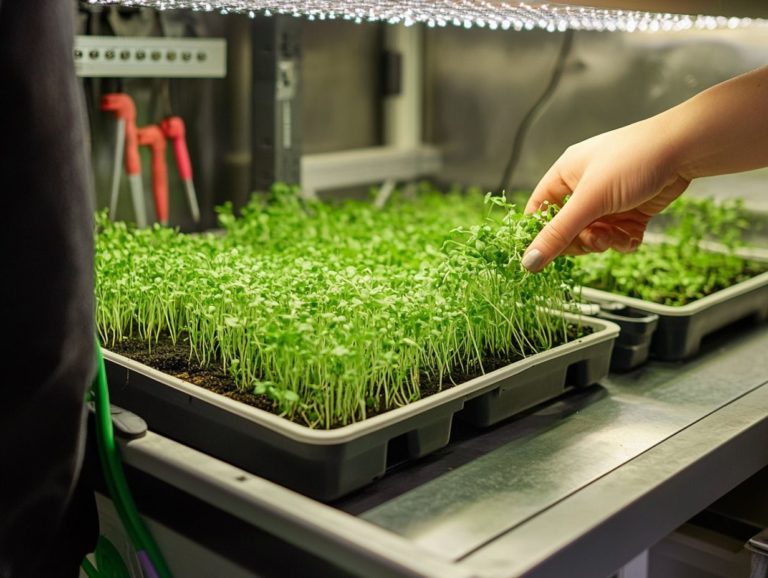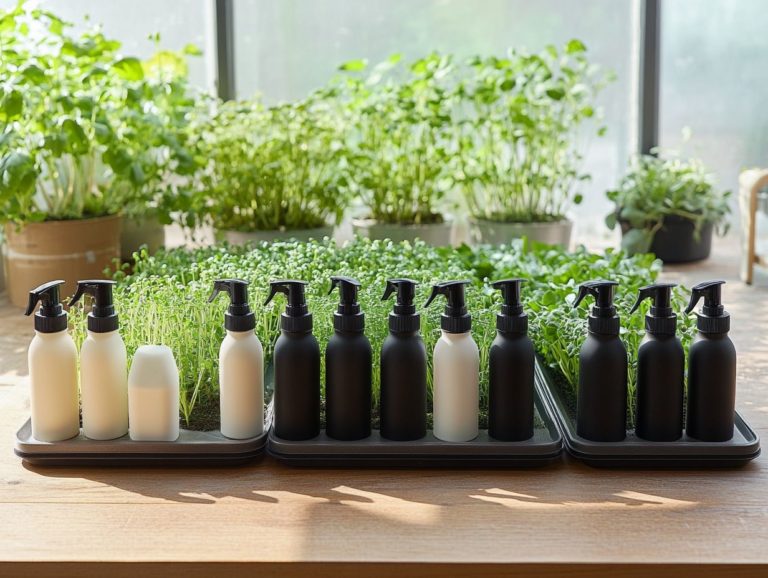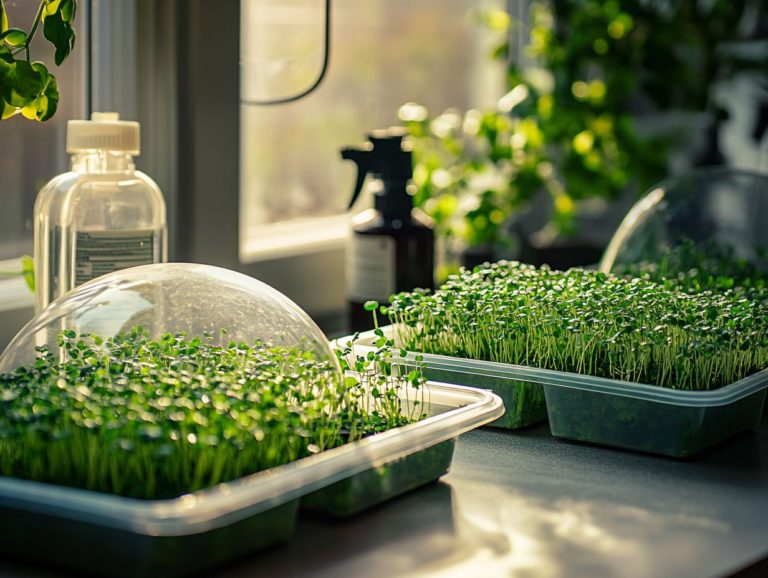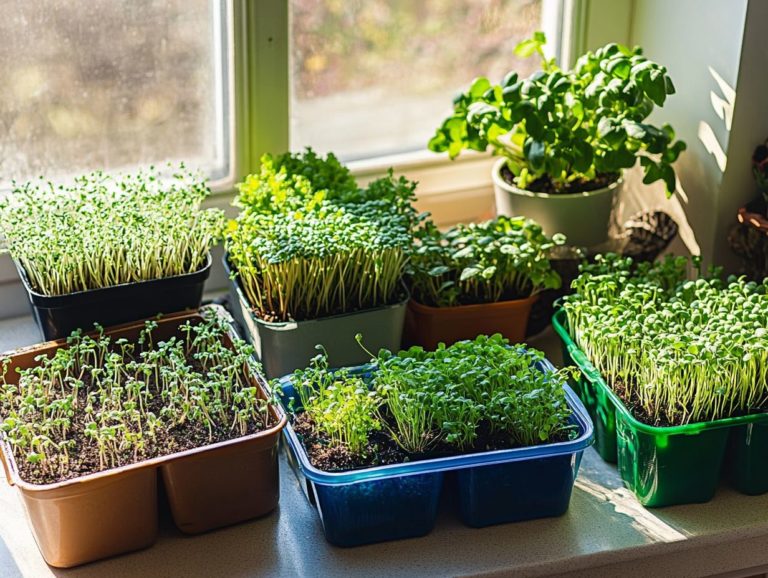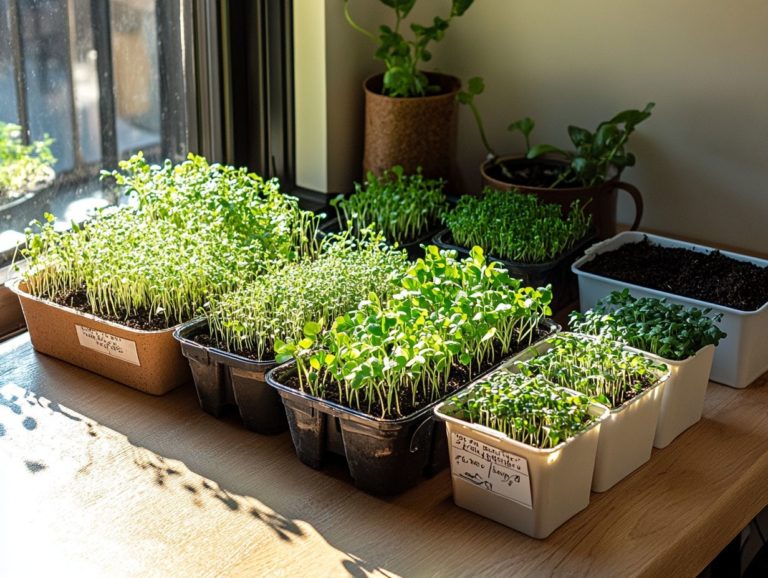Essential Resources for Microgreen Equipment
Microgreens have taken the culinary world by storm, offering an explosion of flavor, color, and nutrition in delightful little packages. If you’re intrigued by this vibrant trend and eager to learn how to cultivate your own, you’re in the perfect spot!
This article explores the numerous benefits of growing microgreens, highlighting their remarkable nutritional value and the potential cost savings they can provide. It also outlines the essential equipment you’ll need from the right trays to proper lighting ensuring that your growing experience is not only rewarding but also successful.
You ll uncover tips for maintaining your setup to optimize results. Let s embark on this exciting microgreen journey together!
Contents
- Key Takeaways:
- Benefits of Growing Microgreens
- Essential Equipment for Growing Microgreens
- Supplementary Equipment for Optimal Results
- Tips for Choosing and Using Microgreen Equipment
- Frequently Asked Questions
- What are essential resources for microgreen equipment?
- Where can I find high-quality trays for microgreen growing?
- What type of growing medium is best for microgreens?
- What type of lighting is needed for microgreens?
- Do I need a specific watering system for microgreens?
- Are there any specialized tools or equipment needed for microgreen production?
Key Takeaways:
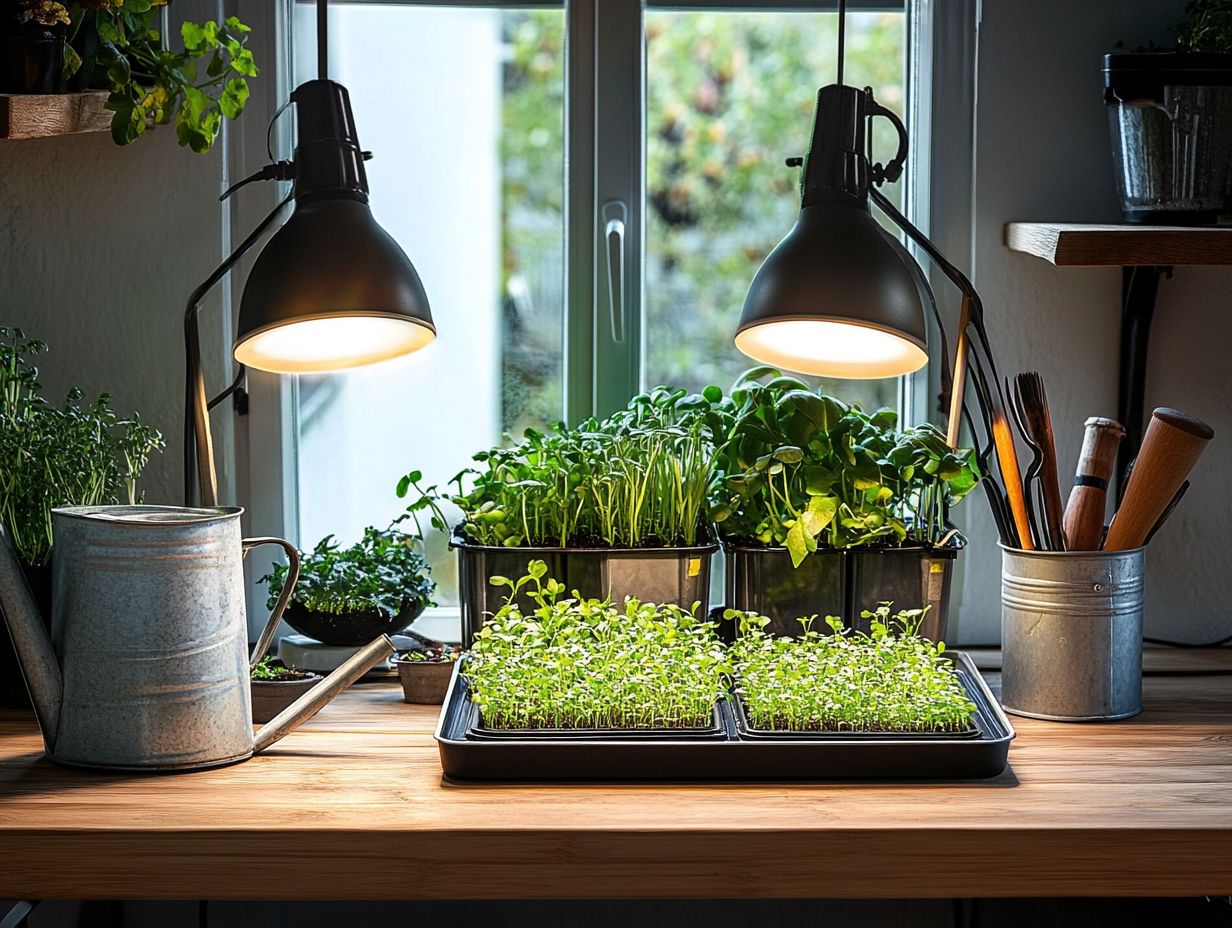
- Invest in the right gear for thriving microgreens!
- Key equipment includes trays, lighting, seeds, and growing medium.
- Humidity domes and growing racks can enhance results but aren’t necessary for beginners.
What are Microgreens?
Microgreens are young edible plants you harvest just after they ve developed their first true leaves. With their vibrant colors and intense flavors, they are a favorite among chefs and urban gardeners alike.
These tiny powerhouses of nutrition, often made up of vegetables like Brassica, pack concentrated doses of essential minerals and vitamins that can elevate your diet.
You can embark on a rewarding journey of growing these greens right in your home garden!
Unlike sprouts, which are simply soaked and rinsed seeds, microgreens are cultivated in soil until they signal readiness for harvest with their first true leaves. This distinction not only enhances their flavor and texture but also adds culinary depth to your dishes.
While mature plants provide fully grown vegetables, microgreens capture the essence of these plants at an earlier stage, maximizing their taste potential in a compact form.
The allure of organic microgreens lies in their environmental sustainability and the ease with which you can nurture them in your home garden. It’s an accessible way for you to enjoy fresh, nutritious greens all year round!
Benefits of Growing Microgreens
Growing microgreens presents a wealth of advantages that elevate your gardening journey to new heights. These tiny powerhouses not only pack an impressive nutritional punch but also offer significant cost savings and a deeply satisfying gardening experience even in the confines of an urban garden.
Microgreens serve as a remarkable source of vitamins and essential minerals, making them an invaluable addition to your diet. Nurturing microgreens can be a financially savvy approach to embracing healthier eating without straining your budget.
Nutritional Value and Cost Savings
Microgreens are celebrated for their impressive nutritional benefits. They often contain higher concentrations of vitamins, minerals, and antioxidants compared to their fully matured counterparts, making them ideal for health-conscious individuals.
Start growing your own microgreens today and watch your grocery bills shrink! These greens can be effortlessly grown at home, allowing you to relish fresh produce without the steep prices typically associated with grocery store purchases.
Research suggests that microgreens can harbor up to 40 times more nutrients than their fully grown vegetable relatives. For instance, red cabbage microgreens are particularly impressive, showcasing high levels of vitamins C and K, crucial for supporting immune function and maintaining bone health.
A study published in the *Journal of Agricultural and Food Chemistry* emphasized that these petite greens are abundant in beneficial plant compounds that help combat oxidative stress.
From an economic standpoint, cultivating a small indoor garden of microgreens not only invests in your personal health but also reduces the frequency of trips to the store, ultimately nurturing a sustainable and budget-friendly lifestyle.
Essential Equipment for Growing Microgreens
To successfully cultivate microgreens, having the right equipment is crucial. It can greatly enhance both your gardening experience and the quality of your harvest.
Essential items include:
- Growing trays or planting trays that ensure proper drainage.
- A suitable growing medium like coconut coir or peat.
- Microgreen seeds that align with your specific goals.
Tools like a spray bottle for misting are essential. They help maintain soil moisture, which is crucial for microgreens.
Growing Trays and Containers
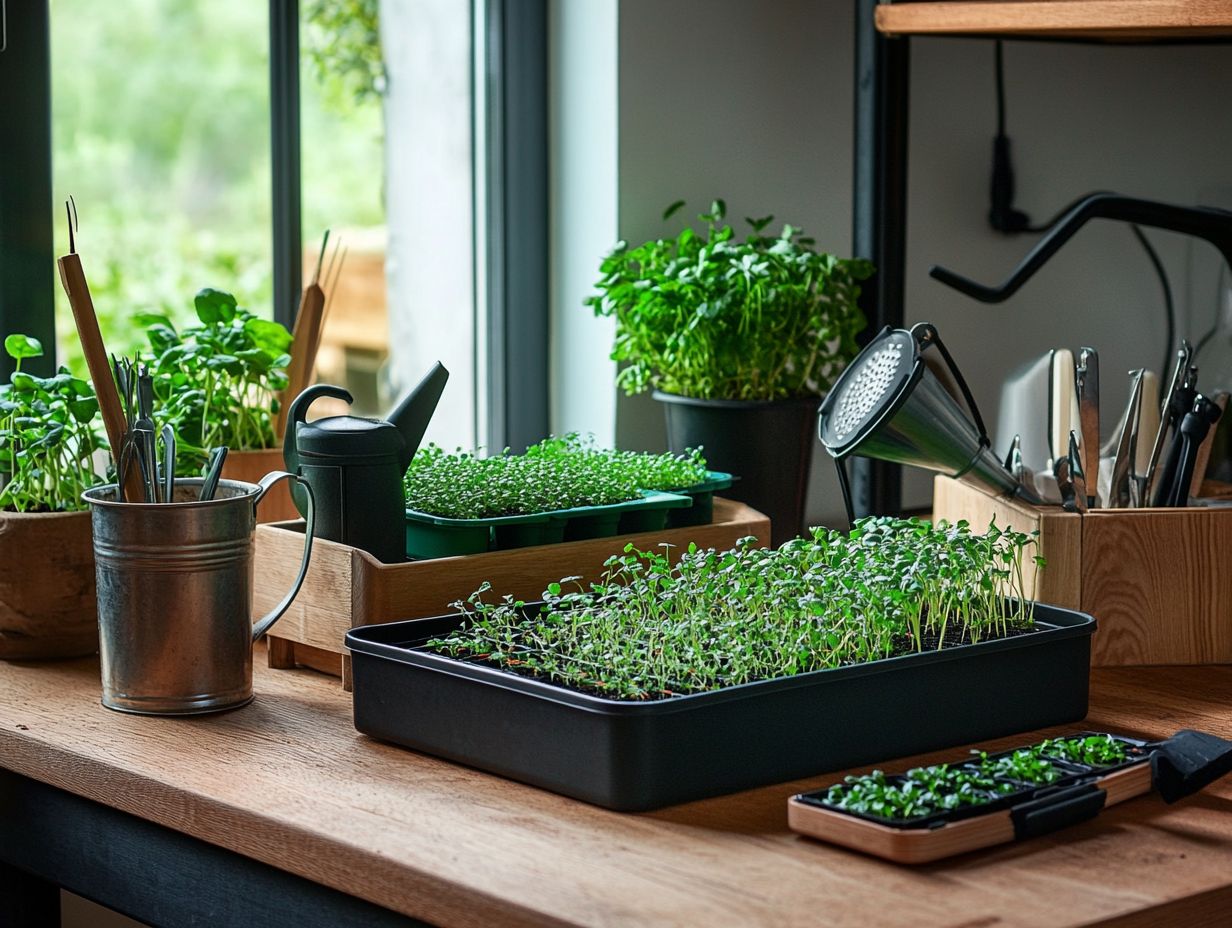
Selecting the right growing trays can make or break your microgreens! It s your first step toward a thriving garden. Look for options that provide adequate drainage and support healthy plant growth.
From standard planting trays to specialized growing trays tailored for microgreens, each choice is vital in maintaining balanced moisture levels in your home garden.
The materials of these containers can vary widely, including plastic, wood, and biodegradable options. Each offers its own unique benefits. For instance, plastic trays often come with built-in drainage holes, ensuring optimal water flow and preventing your plants’ roots from drowning in excess moisture.
On the flip side, biodegradable options may catch your eye if you’re environmentally conscious. They break down over time to enrich the soil.
It’s important to consider how different materials impact heat retention and moisture levels. These factors greatly influence the growth rate and overall health of your microgreens.
Choosing the right container type not only boosts your cultivation efficiency but also elevates the aesthetic appeal of your indoor farming setup.
Lighting and Temperature Control
Effective lighting and temperature control are crucial elements in your journey to grow microgreens successfully. They play a significant role in how fast the seeds sprout and overall plant health.
Utilizing artificial lighting like LED grow lights can replicate natural sunlight. This ensures your microgreens receive the ideal spectrum of light for optimal growth.
To achieve the best results, give your microgreens the light they crave 12 to 16 hours daily is a must for vibrant growth! Maintaining an appropriate temperature range will foster a thriving environment for your plants.
You can effectively use various types of artificial lighting, including fluorescent and high-intensity discharge lights. Tailor your choice to the specific microgreen variety you’re cultivating.
Employing a thermometer and a dimmer switch allows you to maintain consistency in both light and temperature. This makes flexible adjustments as needed based on any environmental changes.
Seeds and Growing Medium
Selecting the right microgreen seeds and growing medium is crucial for a bountiful harvest. Your choice of soil or hydroponic media can significantly influence growth rates and flavor profiles.
Popular growing media options like coconut coir and peat are excellent because they retain moisture effectively while supplying essential nutrients your microgreens need.
Along with coir and peat, explore alternatives like vermiculite and rock wool. Each offers unique advantages. For example, vermiculite helps aerate the soil, promoting healthier root systems, while rock wool shines in hydroponic setups due to its remarkable drainage capabilities.
When choosing microgreen seeds, consider the flavor intensity and nutritional value. Varieties like radish and mustard pack a punch with robust flavors, while sunflower and pea shoots offer a milder taste.
Ultimately, aligning your choice of seeds with the right growing medium can lead to flourishing microgreens that elevate both your meals and your wellness.
Now that you have the essentials, it s time to start growing your own microgreens let’s get started!
Supplementary Equipment for Optimal Results
Ready to take your microgreens to the next level? Investing in supplementary equipment can greatly enhance your growing environment and boost yields.
Tools like humidity domes help keep the soil damp during germination. Fans improve air circulation, which prevents mold and promotes healthier plants.
Humidity Domes and Fans
Humidity domes and fans are crucial tools for microgreen cultivation. They help control moisture levels and airflow both essential for healthy plants.
Using humidity domes during the germination phase creates a warm, moist environment. Meanwhile, fans circulate air to reduce the chances of stagnation.
This setup creates an ideal microclimate for your seedlings. As germination begins, humidity domes trap moisture and warmth, similar to a greenhouse.
Carefully placing fans is important; they not only circulate air but also help remove excess humidity that can lead to fungal issues.
To maximize these tools, regularly check temperature and humidity levels. Adjust the height of your humidity dome as seedlings grow to prevent them from becoming leggy due to lack of light.
Growing Racks and Shelving

Adding growing racks and shelving can greatly improve organization in small gardens or urban spaces. These structures make the most of vertical space, allowing you to grow multiple trays of microgreens while ensuring they get enough light and air.
By using measuring cups for accurate seed density, you can achieve uniform growth. With adjustable shelves and tiered designs, you can easily reach every level, making your gardening experience more ergonomic.
If you enjoy DIY projects, consider building a custom shelving unit with reclaimed wood or metal pipes. Commercial options often come with perks like wheels for mobility and integrated lighting.
These solutions not only save space but can turn even the smallest area into a productive microgreen farm. Don’t wait! Equip yourself with essential tips for growing microgreens at home today and watch your microgreens thrive!
Tips for Choosing and Using Microgreen Equipment
When you embark on the journey of growing microgreens, selecting the right equipment and mastering its maintenance becomes essential for a truly rewarding gardening experience. Consider incorporating nutrient solution to ensure your microgreens thrive.
You should consider factors such as your available space, budget, and the specific types of microgreens you wish to cultivate. Remember, different varieties may demand distinct setups and care routines, so tailoring your approach will set the stage for success. If you’re unsure where to start, check out this guide on how to create a microgreen grow kit.
Factors to Consider and Maintenance Tips
When choosing microgreen equipment, focus on your growing space and the types of microgreens you’re planting. Regularly check soil moisture and clean your trays to keep your plants healthy.
The lighting you choose should align with the unique needs of your microgreens, ensuring optimal photosynthesis. Don t overlook ventilation, as proper air circulation helps prevent mold growth, which can be harmful to those delicate seedlings.
Essential tools include seed spreaders, drainage-friendly trays, and high-quality soil. These components are fundamental to fostering successful growth. For optimal results, consider using the best containers for microgreen cultivation. Establishing a routine for checking on your plants and maintaining cleanliness not only nurtures a thriving environment but also minimizes the risk of pest infestations and diseases in your growing space.
Frequently Asked Questions
What are essential resources for microgreen equipment?
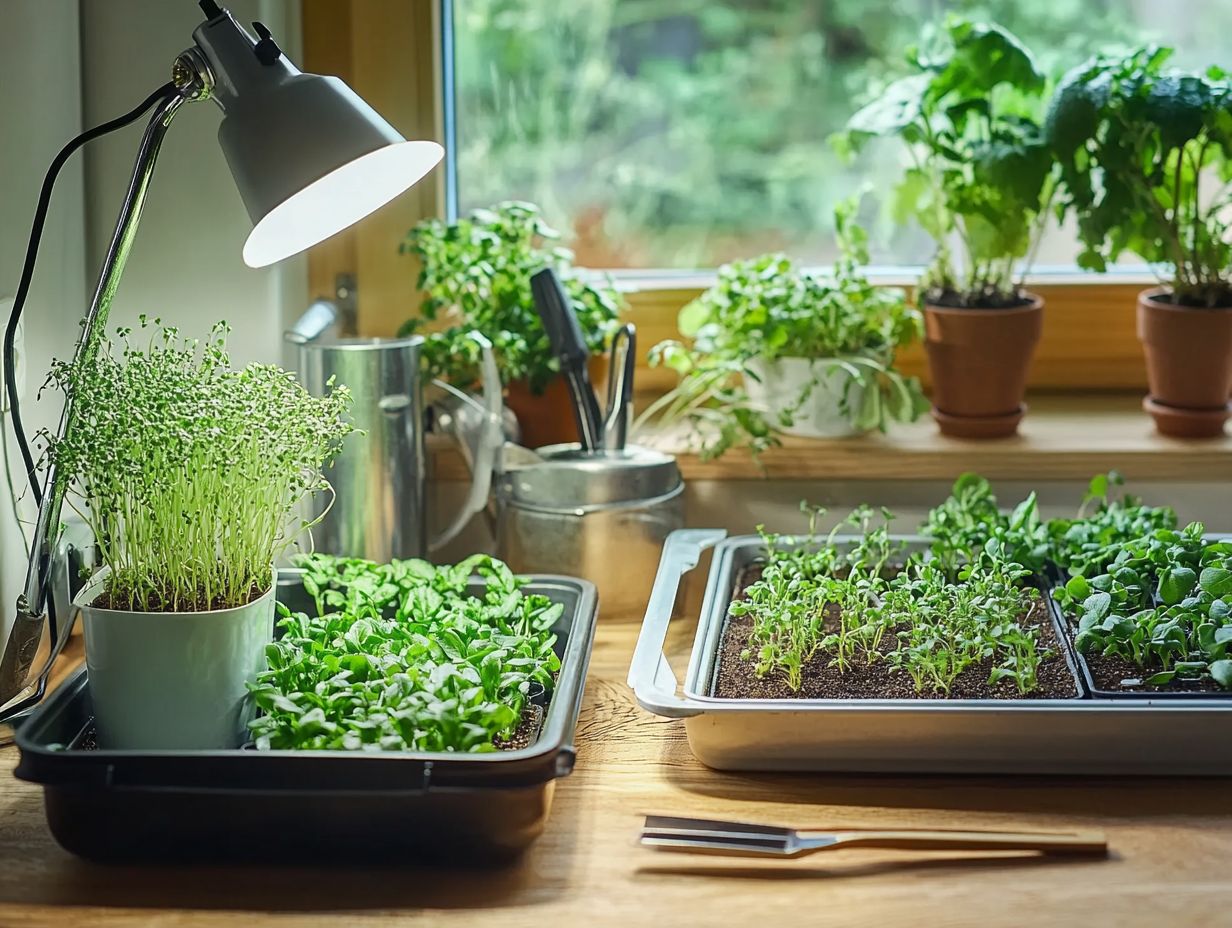
Essential resources for microgreen equipment include trays, growing medium, seeds, lighting, and a watering system, along with pH down for managing nutrient levels.
Where can I find high-quality trays for microgreen growing?
You can find high-quality trays for microgreen growing at your local gardening store, online marketplaces, or through specialty microgreen equipment suppliers. Look for brands like General Hydroponics for reliable options.
What type of growing medium is best for microgreens?
The best type of growing medium for microgreens is a soilless mix made from coco coir, peat moss, and perlite. This provides the optimal balance of moisture retention and aeration for microgreen growth. Try adding ESPOMA products to boost your microgreens growth!
What type of lighting is needed for microgreens?
Microgreens thrive in full spectrum, high-intensity lighting. Use grow lights designed for indoor plants to achieve optimal growth.
Do I need a specific watering system for microgreens?
A bottom watering system is best for microgreens. It prevents mold and keeps plants consistently moist.
Are there any specialized tools or equipment needed for microgreen production?
To grow microgreens successfully, consider using:
- A humidity dome (a cover that maintains moisture).
- A fan to ensure proper air circulation.
- A pH meter, which measures how acidic or alkaline your growing medium is.
These tools help maintain the right environment and ensure great flavor. Don t wait! Make sure you have the right tools to grow healthy microgreens!

